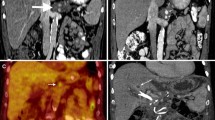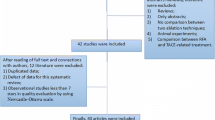Abstract
Purpose
To retrospectively compare the postprocedure pain of hepatocellular carcinoma treated with irreversible electroporation (IRE) with radiofrequency ablation (RFA).
Methods
This Health Insurance Portability and Accountability Act–compliant, institutional review board–approved study compared postprocedure pain in 21 patients (15 men, six women; mean age 61.5 years) who underwent IRE of 29 intrahepatic lesions (mean size 2.20 cm) in 28 IRE sessions with 22 patients (16 men, six women; mean age 60.2 years) who underwent RFA of 27 lesions (mean size 3.38 cm) in 25 RFA sessions. Pain was determined by patient-disclosed scores with an 11-point numerical rating scale and 24 h cumulative hydromorphone use from patient-controlled analgesia pump. Complications were noted. Statistical significance was evaluated by Fisher’s exact test, the Chi-square test, and Student’s t test.
Results
There was no significant difference in the cumulative hydromorphone dose (1.54 mg (IRE) vs. 1.24 mg (RFA); P = 0.52) and in the mean pain score (1.96 (IRE) vs. 2.25 (RFA); P = 0.70). In nine (32.14 %) of 28 IRE sessions and 11 (44.0 %) of 25 RFA sessions, patients reported no pain. Complications occurred in three (10.7 %) of 28 IRE treatments and included pneumothorax (n = 1), pleural effusion (n = 1), and bleeding in the form of hemothorax (n = 1); one (4 %) of 25 RFA treatments included burn.
Conclusion
IRE is comparable to RFA in the amount of pain that patients experience and the amount of pain medication self-administered. Both modalities were well tolerated by patients. Prospective, randomized trials are necessary to further evaluate these findings.


Similar content being viewed by others
References
MedlinePlus. National Library of Medicine, Bethesda, MD. Hepatocellular carcinoma. http://www.nlm.nih.gov/medlineplus/ency/article/000280.htm. Accessed 30 May 2012
Davalos RV, Mir IL, Rubinsky B (2005) Tissue ablation with irreversible electroporation. Ann Biomed Eng 33:223–231
Lee EW, Chen C, Prieto VE et al (2010) Advanced hepatic ablation technique for creating complete cell death: irreversible electroporation. Radiology 255:426–433
Rubinsky B, Onik G, Mikus P (2007) Irreversible electroporation: a new ablation modality—clinical implications. Technol Cancer Res Treat 6:37–48
Teratani T, Yoshida H, Shiina S et al (2006) Radiofrequency ablation for hepatocellular carcinoma in so-called high-risk locations. Hepatology 43:1101–1108
Mahvi DM, Lee FT Jr (1999) Radiofrequency ablation of hepatic malignancies: is heat better than cold? Ann Surg 230:9–11
Goldberg SN, Dupuy DE (2001) Image-guided radiofrequency tumor ablation: challenges and opportunities, part 1. J Vasc Interv Radiol 12:1021–1032
Onik G, Mikus P, Rubinsky B (2007) Irreversible electroporation: implications for prostrate ablation. Technol Cancer Res Treat 6:295–300
Maor E, Ivorra A, Rubinsky B (2009) Non thermal irreversible electroporation: novel technology for vascular smooth muscle cell ablation. PLoS One 4(e4757):1–9
Maor E, Rubinsky B (2010) Endovascular non-thermal irreversible electroporation: a finite element analysis. ASME J Biomech Eng 132:031008
Maor E, Ivorra A, Leor J, Rubinsky B (2007) The effect of irreversible electroporation on blood vessels. Technol Cancer Res Treat 6:307–312
Dupuy DE, Aswad B, Ng T (2011) Irreversible electroporation in a swine lung model. Cardiocasc Intervent Radiol 34:391–395
Lee EW, Thai S, Kee ST (2010) Irreversible electroporation: a novel image-guided cancer therapy. Gut Liver 4:99–104
Neal RE 2nd, Singh R, Hatcher HC et al (2010) Treatment of breast cancer through the application of irreversible electroporation using a novel minimally invasive single needle electrode. Breast Cancer Res Treat 123:295–301
Charpentier KP, Wolf F, Noble L et al (2010) Irreversible electroporation of the pancreas in swine: a pilot study. HPB 12:348–351
Thomson KR, Cheung W, Ellis SJ et al (2011) Investigation of the safety of irreversible electroporation in humans. J Vasc Interv Radiol 22:611–621
Ball C, Thomson KR, Kavnoudias H (2010) Irreversible electroporation: a new challenge in “out of operating theater” anesthesia. Anesth Analg 110:1305–1309
Bruix J, Sherman M (2005) Management of hepatocellular carcinoma. Hepatology 42:1208–1236
Conflict of interest
Dr Govindarajan Narayanan is a consultant for AngioDynamics.
Author information
Authors and Affiliations
Corresponding author
Rights and permissions
About this article
Cite this article
Narayanan, G., Froud, T., Lo, K. et al. Pain Analysis in Patients with Hepatocellular Carcinoma: Irreversible Electroporation versus Radiofrequency Ablation—Initial Observations. Cardiovasc Intervent Radiol 36, 176–182 (2013). https://doi.org/10.1007/s00270-012-0426-9
Received:
Accepted:
Published:
Issue Date:
DOI: https://doi.org/10.1007/s00270-012-0426-9




